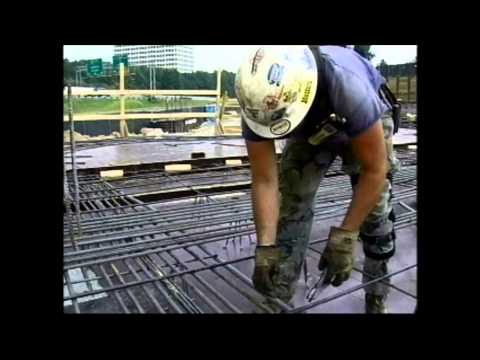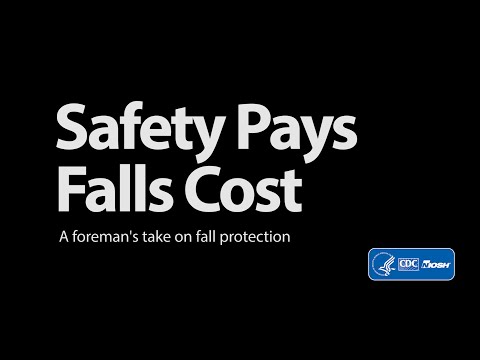It is easy to skip the little safety steps when you're in a hurry, in the zone, or working in the heat. It takes about fifteen seconds to improve your ladder set, but it is much quicker to slide sideways and break your back. Or worse.
Video Transcript:
"I only fell the length of my body, so which is what? 6 foot, so I had to go in for cervical surgery, which was a six hour operation of fusion where they took out the disks and put bones from a cadaver in there. I have steel plates and screws in my neck, which limits my ability to look up and down."
—Dennis Fleming, Electrical Workers Local 164
"I'm very active. Bungee jumps, sky dives, rode motorcycles, played sports with my kids. Right now, I can't run. I can't jump, still can't tie my shoes. And it's put a hold on a lot and hard on the family."
—Glenn Striziver, Sheet Metal Workers Local 137
In far too many cases when workers are injured or killed on the job, it's their loved ones who suffer the most.
"About 2:00 in the morning, I was awoken by someone screaming on their answer machine. I could hear his manager say, "Milly, pick up, pick up." So finally, after he kept calling and calling and woke me up, I answered, and he said that Dan had fallen and that he was in the hospital. We had an extremely happy marriage, which is rare and I just miss him... I loved him so much, and he loved me so much that it's hard to believe that, that wasn't gonna be forever."
—Millie Bevins, Widow of Dan Bevins, Operating Engineers Local 68
Falls are the leading cause of on the job deaths in construction. More than one-third of all deaths in construction are due to falls. And nearly 60% of fatal falls are from head injuries, traumatic injuries, and massive internal injuries. Injured workers and their families find that workers compensation never comes close to restoring their economic security.
"And the financial end of it is just incredible. Granted I got workman's comp, but if you're used to going off and making X amount of dollars a week to bring home, and that's what you're used to living on and now your salary's half of what you normally would go off and bring home. It's almost impossible to ever recover from that."
—Dennis Fleming, Electrical Workers Local 164
Building and construction workers use ladders every day. Yet, like any piece of equipment that's not properly maintained, used and inspected, they can let you down. In fact, your very first step should always be to think about the right ladder for the job. This includes the type of ladder, the length of the ladder, its duty rating, and the ladder material.
Assess whether you need a self-supporting ladder like an a-frame or a portable ladder. To determine the maximum working height on a portable ladder, check the duty rating sticker for its highest standing level and add 5 feet. Also, check the duty rating sticker to be sure that it can support the weight of you and your tools.
Construction jobs should use type one, one A, or one double A which hold up to 250, 300, and 375 pounds respectively. Here's a basic checklist of what to look for each and every time you set up a ladder. Check all of the ladder parts for cracks, bends, splits, or corrosion.
Check all rungs and step connections. Make sure the feet work properly and have slip-resistant pads on the feet. Make sure rung locks and spreader braces are working. Be sure all bolts and rivets are secure.
On extension ladders, make sure the rope and pulley work and the rope is not frayed or tangled.
Finally make sure that the steps, rungs, and other ladder parts are free of oil, grease, and other materials. If you find any damage to a ladder, label it "Do not use" and remove it from the work site for repair or disposal.
"You really got a weigh what you're gonna get, you're taking a chance on this bad ladder for a day's pay. But look what's gonna happen if... Maybe you'll get this day's pay if you get away with it. But if you don't get away with it, what's gonna happen to your family, to you, to the people around you?"
Bill Millea, Roofers Local 4
Over the past decade, the number of people who've died falling from a ladder has nearly tripled. And thousands of workers have suffered disabling falls. Ladder inspection and maintenance are important components of any fall protection program. But even the best-maintained equipment can fail if it's not set up properly.
Checklist for setting up a ladder:
- Position the ladder in the safest location possible. Avoid location hazards such as entry and exit doors, vehicular and pedestrian traffic, uneven flooring, or landing points.
- Don't use a ladder in windy conditions. It is recommended that you stay at least 10 feet away from overhead power lines.
- Prepare firm level footing. If you don't provide a level base, the ladder will become unstable when a worker climbs it.
- Set the ladder at the proper angle. The base should be one foot from the wall for every four feet in height. That makes a 75° angle. An easy way to estimate this angle is to put your toes at the ladder base and extend your arm. Your hands should just reach the ladder rungs. If the rungs are too close to you, the ladder angle is too steep. If the rungs are too far from you, the ladder angle is too broad.
- Extend the side rails at least three feet above the upper level. This allows you to move safely from the ladder to the landing.
- Brace or tie off the ladder near the base. If there is no structure to tie off to, then you can tie it off to a stake in the ground behind the ladder.
- Anchor the top. While getting help to hold the ladder in position, secure the top of the ladder so that it cannot move away from the wall or move laterally. Lashing a rung to an anchor is one way to secure a ladder. Make sure the anchor will hold.
- Barricade or rope off the area around the bottom of the ladder to protect it from traffic.
- Keep the area around the ladder clear of any potential hazards. Clear away debris, clutter, and obstructions from the areas around the bottom and the top.
- A step ladder is not designed to work in the closed position, and should never be used when leaning against a wall.
Now that your ladder is positioned safely, you're ready to use it. Nothing to it, right? You've done it 100 times, but have you ever climbed the wrong side of the ladder? Straddled it or sat on top? Maybe you've walked the ladder to move it. In the construction industry, we all feel tempted to take shortcuts now and then. But shortcuts can end up taking more time, especially when there's an accident.
"The accident wouldn't have happened if we followed normal procedures, just one man on a ladder."
Ed Kandel, Roofers Local 4
Preventing accidents like this is why it's so important to follow this basic checklist for climbing a ladder
Ladder climbing checklist:
- Face the ladder whenever you step on it. Never climb up or down a ladder facing out. Follow the belt buckle rule by keeping your body centered within the side rails of the ladder.
- Use three-point contact. This means that you have two hands and one foot, or one hand and two feet in contact with the ladder at all times. It's the safest and most sensible way to go up and down a ladder, and you'll always be sure to have at least one hand on the ladder.
- Carry no loads. Carry only small objects in a toolkit on your belt. You cannot carry any load that could cause you to lose your balance. Use hoists or chain falls to lift materials.
- Wait for the worker who went up the ladder before you to get all the way off at the top. Then you can climb. This rule applies when coming down the ladder too.
- Maintain stability. Don't pull, lean, stretch, or make sudden moves. These could all cause you to lose your balance, and never try to take a shortcut by walking a ladder over to a new position. Be especially careful as you step on to and off of the ladder.
- Make sure you have the proper foothold of the ladder. You should be able to fit your foot on the step closest to the upper landing, without your toes hitting the wall. On straight or extension ladders, you can climb up only to the fourth rung from the top.
- No standing on top or top step of a step ladder. On an A-frame or a step ladder, you can climb no higher than the second step from the top.
- Never climb on the cross bracing and never sit on any step, including the top.
Construction is dangerous work, but we can make it less dangerous by doing as much as we can to work safely; if not for ourselves, then for our loved ones.
"Everyday make sure you do it correctly.
Put the ladder up right, check it, make sure it's not rotted and nobody gets on there with you and otherwise, when that one accident happens, it's too late, we can't go back.
Like I've said to my father a couple times, "If you could just go back to that one day and just say, 'Let me stay home today with the kids.'" How different everything would have been for everybody."
Bill Millea, Roofers Local 4
There are no guarantees in life, but working the right way goes a long way toward a rewarding career and a prosperous future for you and your loved ones. So let's take as much pride in a job done safely, as in a job done well.












